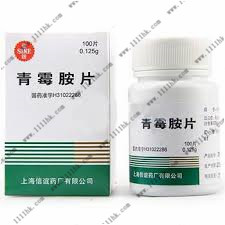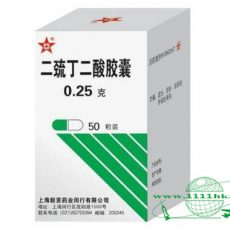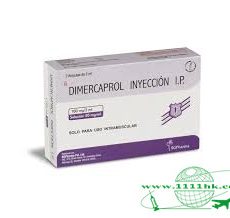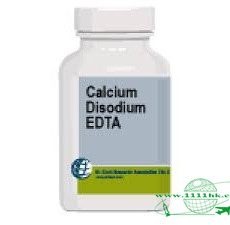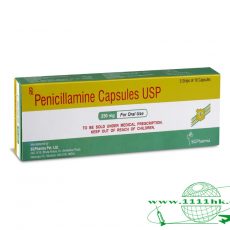-
Hepatolenticular degeneration
D-penicillamine
【Product name】Calcium edetate injection
[English common name]D-Penicillamine
[Chinese common name]D-penicillamine
[English name]3-Mercapto-D-valine
[Chinese other name]3-mercapto-D-proline
[Indications] for the treatment of Wilson's disease, cystineuria and severe.
[Usage and Dosage] Wilson's Disease - The optimal dose can be determined by measuring the measurement of urinary copper excretion and free copper in serum. Urine must be collected in copper-free glassware and copper should be quantified immediately before and after treatment with CUPRIMINE.
Determination of 24-hour urinary copper excretion during the first week of treatment with penicillamine was the most valuable. In the absence of any drug response, a dose between 0.75 and 1.5 g results in over 2 mg of copperuria for the first 24 hours should last for about 3 months, at which time the most reliable method of monitoring maintenance therapy is to determine the serum. Free copper. This is equal to the difference between the total copper and ceruloplasmin-copper quantitatively determined. Well-treated patients usually contain less than 10 mcg of free copper/dL serum. A dose of more than 2 grams per day is rarely required. If the patient is unable to receive CUPRIMINE treatment, the replacement therapy is trientine hydrochloride.
The usual dose of CUPRIMINE for the treatment of cystineuria is 2 g/day for adults, ranging from 1 to 4 g/day. For pediatric patients, the dose can be based on 30 mg / kg / day. The total daily amount should be divided into four doses. If four equal doses are not feasible, give a larger percentage before going to bed. If the adverse reaction requires a dose reduction, it is important to maintain the bedtime dose.
Starting doses of 250 mg/day and gradually increasing to the required amount can more closely control the effects of the drug and may help reduce the incidence of adverse reactions.[Storage] Keep the container closed.
[Tips] Some of the information on this site comes from the Internet and is only used internally by pharmacists or medical staff. It is not a substitute for doctors to diagnose face to face. Please consult a professional pharmacist for specific medications. Please refer to the actual product manual or the actual product for the product content.
-
Hepatolenticular degeneration
Disuccinic acid
【Product name】Chemet
[English common name]Succimer
[Chinese common name]Disuccinic acid
[English name]
[Chinese other name]
[Indications] Used to rescue lead, mercury, arsenic, nickel, copper and other metal poisoning. Good effect on lead poisoning. Can be used for treatmentHepatolenticular degeneration.
[Usage and Dosage] Oral administration once 0.5g, 3 times a day, for 3 days for 1 course of treatment, 4 days for withdrawal; or 0.5g each time, 2 times a day, taking medicine every other day for 10 days, stopping the drug Reuse on the 5th. Usually 2-3 courses can be. Children each time 10mg/kg or 350mg/m2 orally, once every 8 hours, for 5 days, then changed to every 12 hours, for 2 weeks, a total of 19 days for a course of treatment.
[Storage] shading, sealed, and kept in a cool place.
[Tips] Some of the information on this site comes from the Internet and is only used internally by pharmacists or medical staff. It is not a substitute for doctors to diagnose face to face. Please consult a professional pharmacist for specific medications. Please refer to the actual product manual or the actual product for the product content.
-
Hepatolenticular degeneration
Dimercaptopropanol
【Product name】 BAL In Oil
[English common name]Dimercaprol
[Chinese common name]Dimercaptopropanol
[English name]2,3-dimercaptopropanol
[Chinese other name]2,3-dimercaptopropanol
[indications]BAL In Oil(Dimercaptopropanol injection USP) is used to treat arsenic, gold and mercury poisoning. When used simultaneously with the calcium disodium edetate injection USP, it indicates the presence of acute lead poisoning.
[Usage and Dosage] Only through deep intramuscular injection. For mild arsenic or gold poisoning, 2.5 mg / kg body weight, 4 times a day for 2 consecutive days, 2 times for the second time, 1 time thereafter, for 10 consecutive days; for severe arsenic or gold poisoning, every 4 hours 3 mg / kg for 2 consecutive days, 4 times on the 3rd day, then 2 times a day for 10 days. For mercury poisoning, initially 5 mg / kg, then 2.5 mg / kg once or twice daily for 10 days. For acute lead encephalopathy, 4 mg / kg body weight was administered alone in the first dose, and then administered in combination with the USP of ethylenediaminetetraacetate disodium injection administered at a separate site at 4 hour intervals. For less severe poisoning, the dose can be reduced to 3 mg / kg after the first dose. According to the clinical response, the treatment is maintained for 2 to 7 days. Successful treatment depends on starting the injection as early as possible and using a sufficient amount of treatment frequently. Other supportive measures should always be used with BAL in Oil (Dimercaprol Injection USP) therapy.
[Storage] Storage temperature is 20 ° to 25 ° C (68 ° to 77 ° F).
[Tips] Some of the information on this site comes from the Internet and is only used internally by pharmacists or medical staff. It is not a substitute for doctors to diagnose face to face. Please consult a professional pharmacist for specific medications. Please refer to the actual product manual or the actual product for the product content.
-
Hepatolenticular degeneration
Calcium edetate
【Product name】Calcium edetate injection
[English common name]Calcium Disodium Edetate
[Chinese common name]Calcium edetate
[English name]Disodium calcium edta
[Chinese other name]EDTA calcium sodium salt
[Indications] as heavy metal antidote, complexing agent, anti-oxidation synergist, stabilizer and softener; calcium, magnesium and other metal reagents, metal masking agent. Disodium edetate is an important complexing agent for complexing metal ions and separating metals.
[Usage and Dosage] 0.5 to 1 gram per day dissolved in 25% glucose solution 20 ~ 40ml slowly intravenously, or dissolved in 5 ~ 10% glucose solution 250 ~ 500ml, intravenous drip, 3 days for a course of treatment, interval 4 After the second day of treatment. Generally use 2 to 4 courses. Intramuscular injection, 0.25 ~ 0.5g each time, once a day, plus 2% procaine 2ml (first procaine skin test). Pediatric, intravenous drip, each time 12.5 ~ 25mg / kg, twice a day, the maximum dose per day does not exceed 1g, the treatment is the same as above.
[Storage]Sealed and stored.
[Tips] Some of the information on this site comes from the Internet and is only used internally by pharmacists or medical staff. It is not a substitute for doctors to diagnose face to face. Please consult a professional pharmacist for specific medications. Please refer to the actual product manual or the actual product for the product content.
-
scleroderma , Hepatolenticular degeneration
Penicillamine
【Product name】 Cuprimine
[English common name] Penicillamine
[Chinese common name]Penicillamine
[English name]3,3-Dimethyl-D-cysteine
[Chinese other name]3,3-dimethyl-D-cysteine
[Indications] Suitable for heavy metal poisoning,Hepatolenticular degeneration(Wilson's disease), cystineuria and its stones, and also treat serious activities that are ineffective against other drugs.Rheumatoid arthritis.
[Usage and Dosage] Oral, 0.5g-1.5g (4-12 tablets) a day, divided into divided doses. The treatment of hepatolenticular degeneration is 20 mg per kilogram of body weight per day, taken in 3 divided doses. For chronic lead, mercury poisoning is 1g (8 tablets) per day, divided into 3-4 times, 5-7 days for a course of treatment, 2 days after stopping the drug to start the next course of treatment, generally 1-3 courses. The treatment of immune diseases is 1.5g (12 tablets) per day, taken in 3-4 times. Reduce the amount of children used, or follow the doctor's advice.
[Storage] sealed and stored.
[Tips] Some of the information on this site comes from the Internet and is only used internally by pharmacists or medical staff. It is not a substitute for doctors to diagnose face to face. Please consult a professional pharmacist for specific medications. Please refer to the actual product manual or the actual product for the product content.
Hepatolenticular degeneration
Showing all 5 results
